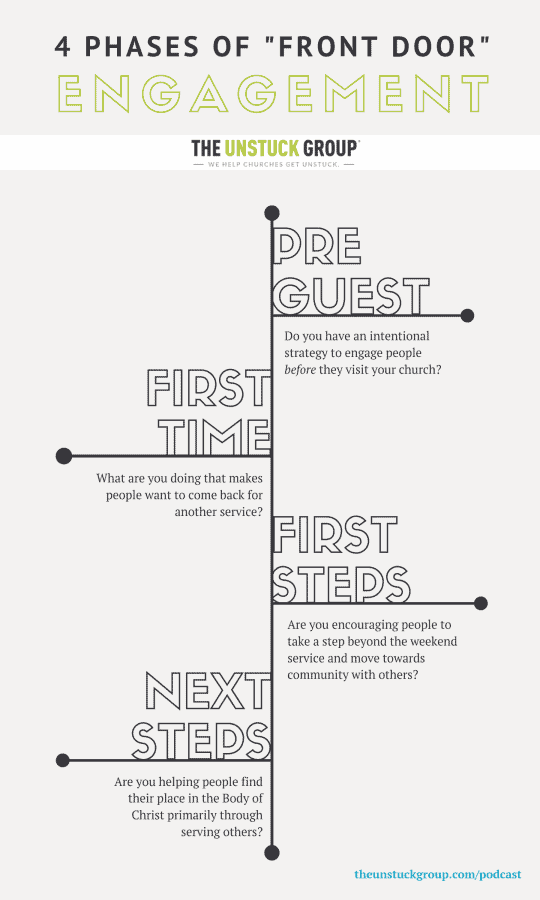Engaging Your Mission Field (Part 3)
If you enjoy this episode, subscribe on your device for more:
iTunes RSS Google Play Stitcher Spotify
We recently began a four-part series to unpack the key steps we see helping churches reach more new guests with the love of Jesus. Here are the four aspects we’re discussing:
I’ve provided a visual below to help—

All four are critical—but we’ve found most churches only have strategies and structure to engage one or two of them.
This week we’re looking specifically at the importance of seeing new guests engaging with our church beyond the weekend experience. There are several key strategies that will help new guests engage in a relationship with someone at the church.
In this third episode of the series, Amy and I share:
- 3 barriers that keep first-time guests from engaging in the church beyond the weekend services
- Practical strategies for helping new attendees take next steps
- How to develop effective online strategies to engage new guests
Leader Conversation Guide
Want to take this conversation back to a staff or senior leadership team meeting?
Our Show Notes subscribers get a PDF download that recaps the episode content and includes a discussion guide you can print out and use at an upcoming meeting.
Opt-in here and get the Leader Conversation Guide for this episode, as well as access to the archive.
Share Your Thoughts and Questions on Social Media
We use #unstuckchurch on Twitter, and we start a real-time conversation each Wednesday morning when the episode drops. You can follow me @tonymorganlive and The Unstuck Group @unstuckgroup. If Facebook is where you spend your time, I’m there, too.
Links & Resources from the Episode
- Pre-Guest Church Engagement – Episode 110 | The Unstuck Church Podcast
- First-Time Guest Engagement – Episode 111 | The Unstuck Church Podcast
- 7 Ways To Grow Church Attendance By Increasing Engagement
Write a Review—It Helps!
Particularly on iTunes, your ratings and reviews really do help more pastors discover the podcast content I’m creating here. Would you take a minute to share your thoughts? Just open the the podcast on iTunes on your phone or computer, click Ratings & Reviews, and leave your opinion.
Transcript
Amy: 00:00 Welcome to our listeners. We’re in week three of a four-week series on front door challenges where we’re discussing the four phases of engaging new attenders and week one was all about strategies to help engage people before they come to our churches. Week two was about the first-time guest experience and if you remember, the purpose of this second phase is just to get them to come back for a second visit and then hopefully a third and a fourth. And today we’re going to talk about the third phase, which is helping guests engage in the church beyond the weekend service. And Tony, we obviously talk about this a lot with the churches we serve. Where do you want to start today?
Tony: 00:37 Yeah, Amy this really is a big deal if we’re going to have healthy front doors to our churches and have healthy churches overall, it’s critical that we see new guests engaging with our church beyond the weekend experience. Now, as we discussed last time on the podcast, it’s a win to get people to attend the weekend service. In fact, if you’re seeing new guests returning a second, third, fourth time, you really should be celebrating. But my point is if that’s all they ever do, we’re really not leading them to becoming a disciple, a fully devoted follower of Jesus. So today we’re going to talk through some strategies that help engage guests beyond the weekend service.
Amy: 01:19 So just to mix it up a little bit, Tony, how about if before we share the best strategies that we’ve experienced through the churches that we work with, what if we start with what’s not working or isn’t working very well? Because I don’t know about you, but those strategies are alive and well.
Tony: 01:34 Yes they are. And why is it that sometimes it’s easier for me to talk about what’s not working? That says something about my personality, doesn’t it Amy? I was thinking that. So these are strategies that are not working. I really do believe churches have good intentions. So it’s not like they’re trying to do things that they know aren’t going to work. But they can be signs that they have forgotten what it is to be a new guest at a church themselves.
Amy: 02:04 Right. All right, well let’s talk through the barriers first that get in the way of guests taking the next step beyond the weekend. What’s the first one?
Tony: 02:11 So the first barrier is anything that takes too much time, and we talk about this a lot on the podcast, but time is the new commodity for people. People are busy. The fact that they’ve already given an hour for a couple of weeks in a row is amazing. I mean, people are gonna think they’re really religious if they’re doing that. You must be doing something right for them to be giving that hour every week. But when you want to help them take their next step, for example, don’t promote a six week class, or not even a two hour class. Make it short. Make it comfortable, make it convenient. You want it to feel doable to a person whose schedule is already most likely very packed. The second barrier that gets in the way of engaging new attenders is, anything that’s too complex. And Amy, you’ve seen this, you’ve been to that church where you’re handed a packed worship program.
Tony: 03:10 We used to call that a bulletin in the old days, Amy and the bulletin is jam packed with every program, event and activity that the church offers. In fact, I’ve shared with you on the podcast, I can look at a church’s program or bulletin and based on the number of activities I can typically tell you the size of the church as well. Because church programs that are filled with events, activities, things like that are usually programs for smaller churches. And what we’ve seen in larger, growing churches is they really narrow the focus on what they’re trying to communicate. I think these churches believe that all of those options will help people connect. But like what Carey Nieuwhof said recently, “faced with too many choices, most people choose nothing.” And we need to make that next step for new attenders.
Tony: 04:04 And really we need to make the next steps for all attenders clear. And in that same article, Carrie added, the clearer and simpler the path is toward engagement, the more people will travel it. And especially for new people, they need clarity on what their next step should be.
Amy: 04:24 Gotcha. So the first one you said anything that takes too much time is a barrier. The second was anything that’s too complex. Anything else?
Tony: 04:31 Yeah, the third barrier that gets in the way of engaging new attenders is anything that feels like a commitment. Which sounds a little counterintuitive. I mean, we really want people to be committing their lives to Jesus as an example and making commitments in their life beyond that. But it isn’t unusual for us to see churches right after the welcome section of the worship program as an example, to challenge people to join a small group or to start serving or even become a member.
Tony: 05:00 All things that require a lot of commitment, at least on the surface. And these really can be great next steps for regular attenders. People that have clearly made your church their church home, but we’re still talking about engagement strategies for the very new people to your church. And those are pretty big next steps for a new person. Now, beyond those three things we talked about, things that take too much time, things that are too complex, things that feel like a commitment being barriers to next step engagement. Let me just also in this category say, it’s probably just a pet peeve of mine, but commonly I will see churches identify the person that’s responsible for these first steps that people are trying to take to connect with a church. They call this an assimilation process. And I just saw it again this past week. There’s a pastor or director of assimilation and that just sounds awful to be advocating that people new to your church would get assimilated to your church. Sounds kind of freaky actually, so…
Amy: 06:13 Well, you know what I think of, it was one of the Star Trek shows, and “we will assimilate you” was kind of their tagline, the bad guys. We will assimilate you. And I think of it every time I see that title.
Tony: 06:27 Yeah. Well, again, final thing is, we have to avoid things that feel like a big commitment that we’re asking people to take.
Amy: 06:35 Yeah, it’s really true. You know, Tony, I do see that membership thing all the time and I always cringe a little bit, especially when membership is highlighted as the next step and usually in the form of a question like, are you ready to be a member? It’s on the connect cards churches have when they’re telling me to fill it out when I secret shop. And that’s one of the headline questions, and I’ve said this before, but I think in today’s culture people really aren’t looking to be a member of anything. And I think it makes churches feel out of touch. If that’s too big of a headline. Well anyways, let’s switch gears to what is working to help new attenders take a next step beyond the weekend.
Tony: 07:09 So, let’s start by defining what I believe is the win for this third phase of an engagement. So to recap, the first phase we talked about was the preguest experience or pre guest engagement. And we said the win was to inspire your congregation to build relationships with people outside the faith and the church. And the research actually shows that 75 to 90% of people will come to your church through an invitation of a friend or a family member. And then last week we talked about the second phase of engagement, getting a guest to come back for a second time and then hopefully a third time and a fourth time. Well, the win for this third phase of engagement is helping people take a step towards community, helping a guest engage in a relationship with someone at the church.
Amy: 08:02 Again, probably easier said than done. So what are some effective approaches to do that?
Tony: 08:07 So here’s what we’re seeing in churches that are doing this effectively. And first let me say this, there’s no silver bullet. There’s no one way to make this happen. We’re hopefully reaching a diverse mix of people and we have to hold tight to the win, which is to engage them with other people while holding loosely to the methods to accomplish that. The methods will need to continuously change, especially as our culture changes and the people we’re trying to reach are changing. But here’s what we’re seeing when it comes to helping new attenders take their next steps. At first it begins with an expectation that they should take a next step. So what that means is pastors need to preach this announcement. In other words, pastors need to regularly build vision around next steps from the platform. They need to make it normal so that people who are following Jesus understand. We need to be connected with the church and connected with other believers. And of course this isn’t just for new people, but all attenders. We need to build this into the culture, this expectation that people do more than just attend. They really do need to take a next step. Secondly, it needs to be simple and clear. We don’t want to make people go through hoops to take this next step. So some churches invite new people to hang out after the service and take just 15 minutes to meet them. They introduce themselves, they introduce the pastor or they point them to a next step. This brief gathering at the service connects new attenders with other new attenders. And when the right person facilitates this, it’s going to help new people get to know one another a little bit better.
Tony: 09:55 So often, the next step they point to is a 30 to 60 minutes event. And by the way, not a class, and I’ll come back to that in a moment, that gives an overview of what the church is all about. So often we’ll hear this type of experience called something like “starting point” or “next step” or something along those lines. It gives new attenders an understanding of the church’s mission and the discipleship pathway, making it clear for new people. This is the why behind the steps that we’re encouraging you to take. This is the why behind being in a small group or serving and it works best when this event is right before or after a weekend service. And that makes it easy for someone new to leverage their time as they’re already at church. They don’t have to come back to church to experience this event.
Tony: 10:47 And let me share a side note here. I mentioned I’d come back to this, Amy. I don’t think it’s helpful to label this experience a class. I really don’t think people in today’s day and age are looking to attend classes anymore. They want to get better at life. And so encouraging them to take a next step in an experience after your services that offers them an opportunity for how they can get better at life by connecting with other people and connecting to the church. I think there’s an opportunity there for us just to think about the language we’re putting around these next steps as well whatever that next step is. There needs to be a leader that owns it. In fact, we recommend that there is one staff champion and one team that owns all four of these phases. And it goes back to “if everybody owns it, nobody owns it.” So, In fact, you shared a joke with me around this recently. What was it? It had something to do with feeding a dog? I love that joke. I probably say it too much
Amy: 11:54 How do you starve a dog? Give 10 people the responsibility to feed it.
Tony: 11:58 Very good. Have you ever thought about standup comedy?
Amy: 12:03 I have thought about that. Yeah.
Tony: 12:06 So one leader on the team needs to own this. And so, we’ve seen churches do this by creating a team whose job is to meet new people and point them towards their next step. One of the churches we’re working with does this very well. They actually have goals related to how many first, second, third time guests they’re trying to connect with each weekend. So yeah, having one team that owns all of these phases of engagement and really leading people into our discipleship process.
Amy: 12:37 Tony, you mentioned the church that we’re working with who is currently doing that? They have that team focused on connecting with first, second, third time guests. Do you ever see any downside to this? Like the community aspect maybe feels manufactured?
Tony: 12:52 I get what you’re getting at there. But really I don’t see a downside in how this plays out because really what we’re doing is just bringing clarity to the value, the motivation that we’re trying to provide people. We want new people to get connected. And by the way, this team needs to be gifted in the hospitality area. I love what Life Church does in this area. They train these new team members to comfortably get to know new attenders by asking questions about family, occupation, recreation. I mean, they’re intentionally training team members to make these initial connections and it’s paying off for them.
Amy: 13:30 It makes so much sense. I mean, in my secret shopper experiences, I’m uncomfortable, right? Coming into a new environment, it’s amazing to me how many of the people they have in first time guest areas that are also amazingly uncomfortable. And so that training must go a long way just to have a couple of questions loaded that you can start the conversation with. So any other best practices that you’ve seen, Tony?
Tony: 13:53 Yeah, I’ve covered some of these in the past, but there are several, the best practices that we’re seeing is to first invite people to join you right after the service for about 10 minutes. Use this time to connect with new attenders as well as connect with one another. “Meet the pastor,” call it whatever you want. Just don’t call it a class and make sure it’s casual, shake hands or introduce yourself. Point people to their next step. I should mention that it’s important that you have communicated that their kids will be fine in kid’s ministry while you do this. In other words, make sure your kid’s team knows that this is happening and that some parents will be a little bit late picking up their kids. A second best practice is to have short events that are offered before and after the regular service times that will further introduce people to your church.
Tony: 14:47 It should be focused on the church’s mission and the discipleship path though, and not membership. Again, I don’t think new people are looking to become members. That’s a big commitment, but just help them figure out what their next step is by connecting to your church and connecting with others. That’s the direction you want to go. The third best practice is to have easy ways for people to sign up for the starting point event. You need to recognize that some people are extroverts and will be comfortable talking to someone about how to sign up. Others are introverts like me and they need more processing time. There should be an easy way online to sign up for these types of gatherings. And again, that event should be focused on the why behind next steps and the why behind your church. And then lastly, consider actually providing this opportunity online.
Tony: 15:38 And while this option doesn’t connect the new people with other people, it does give people the opportunity to take a low risk next step. And that’s what the win is here. So if you offer an online option for this, make sure that you are asking for some information that will allow your team to follow up with those people and encourage them to take the next step.
Amy: 16:01 Those are great. I like the laser focus and just getting them to do something beyond the weekend service. Tony? Any closing thoughts?
Tony: 16:08 Yeah, I do. I want to go back to Carey Nieuwhof, not just because he’s a good guy. I think he has a lot of good things to say on this topic of engagement. And recently he had a blog post that talked about making it uncomfortable to stay disengaged in our churches, and he said, when you don’t expect people to do more than to attend your church, don’t be surprised if all they do is attend your church. I mean, that’s just so true. As church leaders, we need to have a relentless passion and focus on getting all people to take the next steps of engaging in the pathway towards becoming more like Jesus.








Leave a Reply